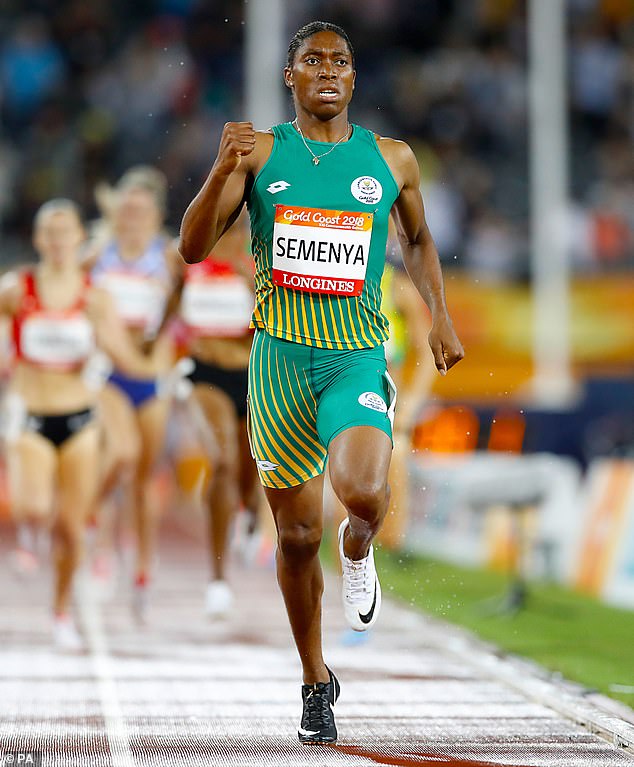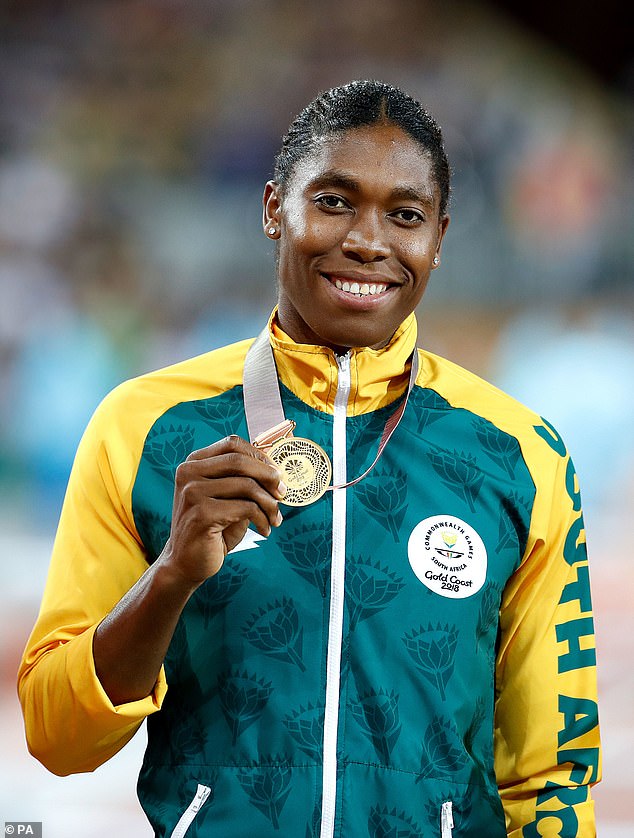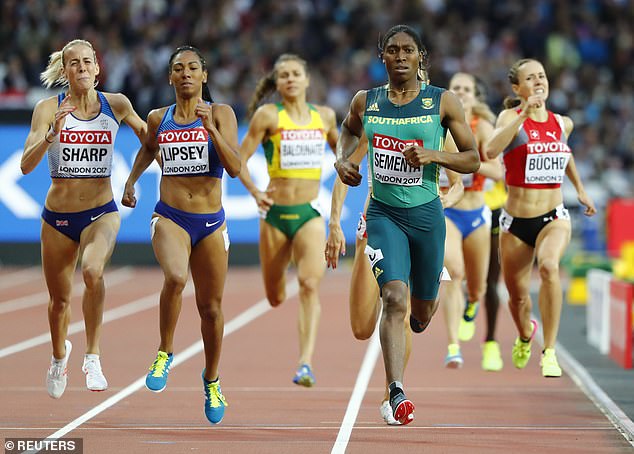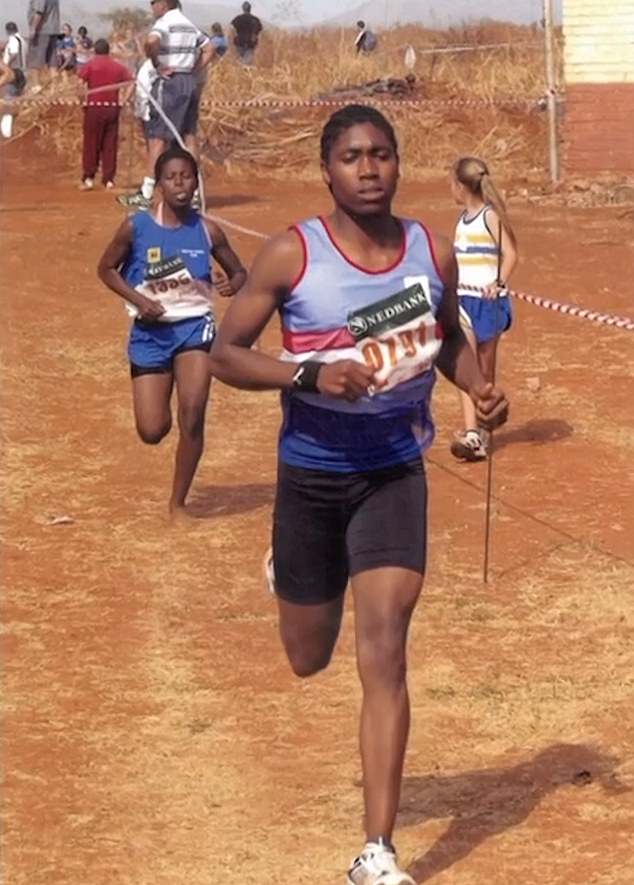‘Being born with internal testicles doesn’t make me less of a woman’: Olympic champion Caster Semenya says ‘I won’t be ashamed because I am different’ as her battle with athletic authorities continues
Olympic champion Caster Semenya has said that ‘being born with internal testicles does not make her less of a woman’ and accused athletic leaders of ‘turning women against women’ as she continues her battle with sports authorities.
The South African runner, 32, who won Olympic gold in the 800 meters in 2012 and 2016, said she “will not be ashamed of being different” and will “fight for what is right” in athletics.
Semenya was legally identified as female at birth, but has a condition that causes her body to naturally produce higher levels of testosterone than women without the condition.
But in 2018, World Athletics introduced rules that required Semenya and other athletes with differences in sexual development (DSD) to take hormone-suppressing drugs to compete at distances between 400 meters and a mile.
Semenya has since refused to take medication, meaning she will no longer be allowed to compete in her favorite distance of 800 meters.
But the Olympic champion continues to battle sports authorities, hoping to overturn demands that female athletes with differences in sexual development lower their levels of testosterone, a hormone that increases muscle mass and strength.
“It’s no longer about me fighting to compete, it’s about fighting for what’s right,” Semenya told BBC Sport. ‘Fighting for the next generation, because there are many children who are affected by the same ruling.’
The South African runner, 32, who won Olympic gold in the 800 meters in 2012 and 2016, said she “will not be ashamed of being different” and will “fight for what is right” in athletics.

South Africa’s Caster Semenya competes in the Women’s 1500m final at Carrara Stadium during the 2018 Commonwealth Games
She added: ‘I’m a woman, I have a vagina just like any other woman… I know I’m a woman, I don’t really care about the medical terms – my testosterone, you know I was born without a uterus Just because I was born with internal testicles doesn’t make me any less of a woman.
“The difference is what I was born with and I embrace them. I’m not going to be ashamed because I’m different. I’m different, I’m special and I’m grateful for it.’
After a failed appeal to the Court of Arbitration for Sport (CAS) in 2019 and a Swiss Federal Court in 2020, the European Court of Human Rights ruled in favor by a majority of four to three in July this year from Semenya. the latter had not been properly listened to and she was the victim of discrimination.
But Swiss authorities, backed by World Athletics, had announced their intention to refer the case to the Grand Chamber of the ECtHR, whose rulings are binding. The Grand Chamber decided to rule on the case on Monday.
Semenya said she is not focused on competing as next year’s Olympics are not in her plans, but is instead focusing on fighting for “justice, inclusivity and diversity.”
“The importance of women’s sports is not taken seriously,” she said. ‘We as women need to take charge of our own bodies, we need to decide what is good for us – not let any other gender tell us what we should look like, whether we are woman enough or not. It’s up to us.’
In response to the ECHR ruling, World Athletics had defended its regulations as a ‘necessary, reasonable and proportionate means of protecting fair competition in the female category’.
But in response, Semenya told the BBC: ‘My testosterone is high and not active because I am not a man. I believe that I, like any other woman, have the right to compete as a woman.
“For me, it’s about empowering women… you have to go out and fight for what’s right. I know what’s right.’
Semenya, who won Olympic gold in the 800 meters in 2012 and 2016 and is a three-time world champion in the same distance, said last week that she had achieved everything she wanted on the track and is now focusing on her fight with the sport’s authorities.
“As for me, I’m not going to allow leaders who come into our company for selfish means to destroy it. I’m all about empowering women and making sure they have a voice.”
The ECHR ruling in July was largely symbolic as it does not challenge the World Athletics ruling and does not clear the way for Semenya to return to competition without taking the medication.

Caster Semenya celebrates with her gold medal in the Women’s 800m final at Carrara Stadium during day nine of the 2018 Commonwealth Games

Caster Semenya of South Africa, Charlene Lipsey of the US and Lynsey Sharp of Great Britain compete in the semi-final of the women’s 800 meters at the World Athletics Championships in August 2017

In the photo: Semenya participates in a race in her younger years
World Athletics introduced the DSD rules to create a level playing field in women’s events ranging from 400 meters to one mile.
Semenya was forced to move up to the 5,000 meters, a distance at which she failed to reach the final at last year’s world championships in Eugene, Oregon.
In March this year, the federation changed the rules. DSD athletes must now reduce their blood testosterone levels to less than 2.5 nanomoles per liter, down from the previous level of five, and remain below this threshold for two years.
World Athletics also removed the principle of limited events for DSD athletes, meaning the regulations now cover all distances.
During her career, her personal medical records were leaked after she had to take a test to prove she was a biological female. The results showed that she was born without ovaries or uterus and had internal testicles.
Her testosterone level was three times higher than what was considered ‘normal’ for a woman at the time.
She had to take a test to prove she was a woman, which revealed that her reproductive organs were different from those of most women – something the athlete was previously unaware of.
The test results were eventually leaked and made public without her consent.
